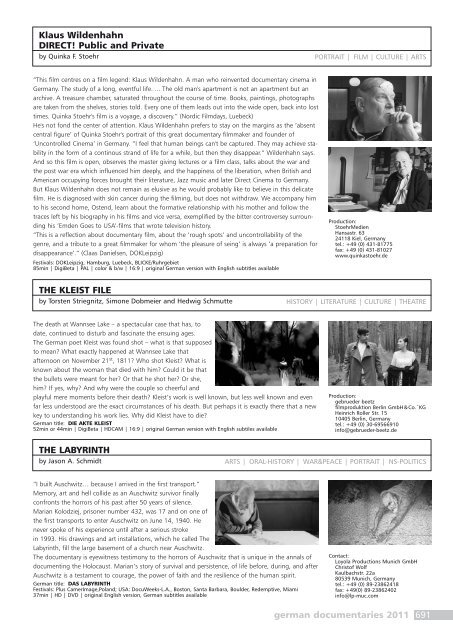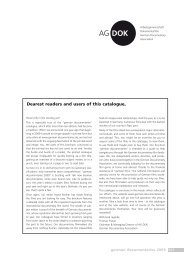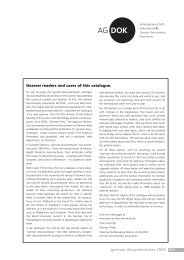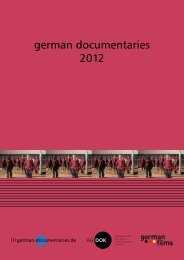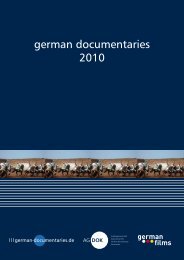german documentaries 2011
german documentaries 2011
german documentaries 2011
Create successful ePaper yourself
Turn your PDF publications into a flip-book with our unique Google optimized e-Paper software.
Klaus Wildenhahn<br />
DIRECT! Public and Private<br />
by Quinka F. Stoehr PORTRAIT | FILM | CULTURE | ARTS<br />
“This film centres on a film legend: Klaus Wildenhahn. A man who reinvented documentary cinema in<br />
Germany. The study of a long, eventful life. ... The old man's apartment is not an apartment but an<br />
archive. A treasure chamber, saturated throughout the course of time. Books, paintings, photographs<br />
are taken from the shelves, stories told. Every one of them leads out into the wide open, back into lost<br />
times. Quinka Stoehr's film is a voyage, a discovery.” (Nordic Filmdays, Luebeck)<br />
He's not fond the center of attention. Klaus Wildenhahn prefers to stay on the margins as the ‘absent<br />
central figure’ of Quinka Stoehr's portrait of this great documentary filmmaker and founder of<br />
‘Uncontrolled Cinema’ in Germany. “I feel that human beings can't be captured. They may achieve stability<br />
in the form of a continous strand of life for a while, but then they disappear.“ Wildenhahn says.<br />
And so this film is open, observes the master giving lectures or a film class, talks about the war and<br />
the post war era which influenced him deeply, and the happiness of the liberation, when British and<br />
American occupying forces brought their literature, Jazz music and later Direct Cinema to Germany.<br />
But Klaus Wildenhahn does not remain as elusive as he would probably like to believe in this delicate<br />
film. He is diagnosed with skin cancer during the filming, but does not withdraw. We accompany him<br />
to his second home, Ostend, learn about the formative relationship with his mother and follow the<br />
traces left by his biography in his films and vice versa, exemplified by the bitter controversey surrounding<br />
his ‘Emden Goes to USA’-films that wrote television history.<br />
“This is a reflection about documentary film, about the ‘rough spots’ and uncontrollability of the<br />
genre, and a tribute to a great filmmaker for whom ‘the pleasure of seing’ is always ‘a preparation for<br />
disappearance’.” (Claas Danielsen, DOKLeipzig)<br />
Festivals: DOKLeipzig, Hamburg, Luebeck, BLICKE/Ruhrgebiet<br />
85min | DigiBeta | PAL | color & b/w | 16:9 | original German version with English subtitles available<br />
The death at Wannsee Lake – a spectacular case that has, to<br />
date, continued to disturb and fascinate the ensuing ages.<br />
The German poet Kleist was found shot – what is that supposed<br />
to mean? What exactly happened at Wannsee Lake that<br />
afternoon on November 21st , 1811? Who shot Kleist? What is<br />
known about the woman that died with him? Could it be that<br />
the bullets were meant for her? Or that he shot her? Or she,<br />
him? If yes, why? And why were the couple so cheerful and<br />
playful mere moments before their death? Kleist’s work is well known, but less well known and even<br />
far less understood are the exact circumstances of his death. But perhaps it is exactly there that a new<br />
key to understanding his work lies. Why did Kleist have to die?<br />
German title: DIE AKTE KLEIST<br />
52min or 44min | DigiBeta | HDCAM | 16:9 | original German version with English subtiles available<br />
Production:<br />
StoehrMedien<br />
Hansastr. 63<br />
24118 Kiel, Germany<br />
tel.: +49 (0) 431-81775<br />
fax: +49 (0) 431-81027<br />
www.quinkastoehr.de<br />
THE KLEIST FILE<br />
by Torsten Striegnitz, Simone Dobmeier and Hedwig Schmutte HISTORY | LITERATURE | CULTURE | THEATRE<br />
“I built Auschwitz… because I arrived in the first transport.”<br />
Memory, art and hell collide as an Auschwitz survivor finally<br />
confronts the horrors of his past after 50 years of silence.<br />
Marian Kolodziej, prisoner number 432, was 17 and on one of<br />
the first transports to enter Auschwitz on June 14, 1940. He<br />
never spoke of his experience until after a serious stroke<br />
in 1993. His drawings and art installations, which he called The<br />
Labyrinth, fill the large basement of a church near Auschwitz.<br />
The documentary is eyewitness testimony to the horrors of Auschwitz that is unique in the annals of<br />
documenting the Holocaust. Marian’s story of survival and persistence, of life before, during, and after<br />
Auschwitz is a testament to courage, the power of faith and the resilience of the human spirit.<br />
German title: DAS LABYRINTH<br />
Festivals: Plus CamerImage,Poland; USA: DocuWeeks-L.A., Boston, Santa Barbara, Boulder, Redemptive, Miami<br />
37min | HD | DVD | original English version, German subtitles available<br />
Production:<br />
gebrueder beetz<br />
filmproduktion Berlin GmbH & Co.˘KG<br />
Heinrich Roller Str. 15<br />
10405 Berlin, Germany<br />
tel.: +49 (0) 30-69566910<br />
info@gebrueder-beetz.de<br />
THE LABYRINTH<br />
by Jason A. Schmidt ARTS | ORAL-HISTORY | WAR&PEACE | PORTRAIT | NS-POLITICS<br />
Contact:<br />
Loyola Productions Munich GmbH<br />
Christof Wolf<br />
Kaulbachstr. 22a<br />
80539 Munich, Germany<br />
tel.: +49 (0) 89-23862418<br />
fax: +49(0) 89-23862402<br />
info@lp-muc.com<br />
<strong>german</strong> <strong>documentaries</strong> <strong>2011</strong> 691


